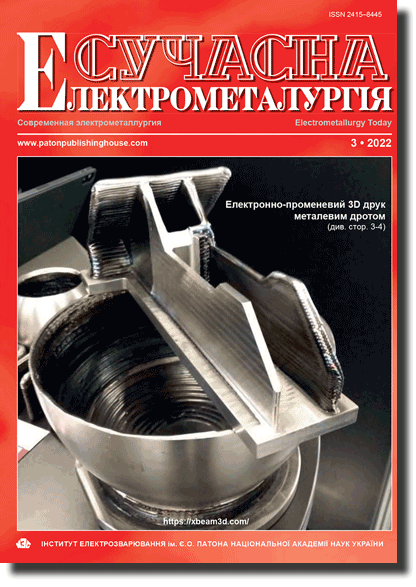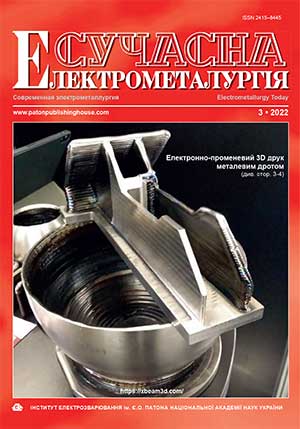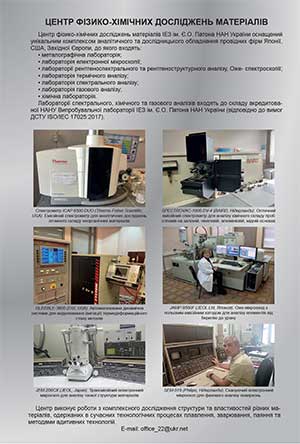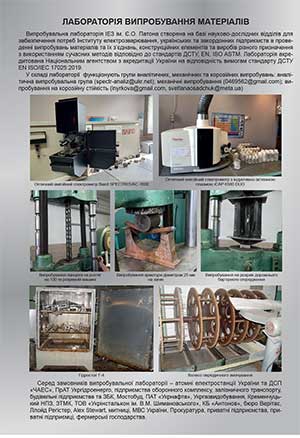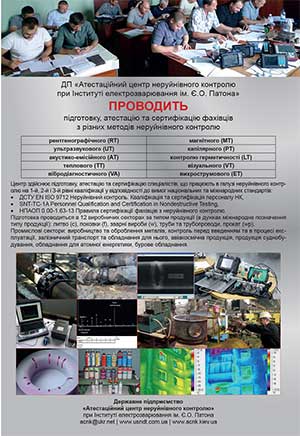| 2022 №03 (05) |
DOI of Article 10.37434/sem2022.03.06 |
2022 №03 (07) |
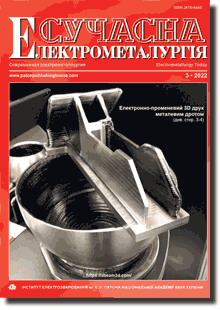
"Suchasna Elektrometallurgiya" (Electrometallurgy Today), 2022, #3, 38-43 pages
Composition of zirconium alloy ingots of Zr–Nb–Ti system melted by integrated vacuum-arc technology
O.Ye. Kapustian, T.О. Akrytova
National University «Zaporizhzhsіa Polytekhnika». 64 Zhukovskyi Str., 69063, Zaporizhzhіa, Ukraine. E-mail: aek@zntu.edu.ua
Abstract
The chemical composition of zirconium alloy ingots of the Zr–Nb–Ti system was studied. The ingot of the experimental zirconium alloy was smelted by the method of complex melting. Ingots with a diameter of 120 mm were obtained by a single vacuum-arc remelting in a copper crystallizer of consumable electrodes with a diameter of 50 mm, previously obtained by vacuum-arc remelting with a non-consumable electrode in a vacuum arc furnace. This method allows obtaining chemically homogeneous ingots. The content of the main alloying elements was assessed using a scanning microscope, and of oxygen — using a gas analyzer. The transition coefficients of the charge elements at vacuum-arc remelting with a consumable electrode are determined. It is established that the content of the main alloying elements in the ingots of vacuum-arc remelting corresponds to their estimated composition. The chemical composition of Zr–Nb– Ti alloy ingots was studied, and it was shown that the material is characterized by a fairly high homogeneity throughout the ingot structure without signs of zonal segregation. The results of the microanalysis established the absence of heterogeneity in the study area. Examination of the ingot metal by ultrasonic flaw detection of the alloy showed the absence of internal structural defects. Thus, a complex technology that includes vacuum-arc remelting with a non-consumable electrode in a vacuum arc sealing furnace and vacuum-arc remelting in a crystallizer with a consumable copper electrode is an effective way to obtain zirconium alloy ingots of the Zr–Nb–Ti system. This technology eliminates the shortcomings of other existing technologies and provides high-quality ingots of zirconium alloy. Ref. 16, Tabl. 1, Fig. 4.
Keywords: vacuum-arc remelting; zirconium alloy; ingot; chemical composition; conversion factor; quality; technology
Received 26.05.2022
References
1. Maksyuta, I.I., Kvasnitskaya, Yu.G., Lashneva, V.V. (2011) Methods for producing highly refined cobalt-chromium based alloys for medical purposes Advances in Electrometallurgy, 3, 185-190.2. Gunter, V.E., Khodorenko, V.N., Yasenchuk, Yu.F. (2006) Titanium nickelide. New generation medical material. Tomsk, MITs [in Russian].
3. Kostin, V.A., Grigorenko, G.M. (2019) Computer modeling of structural transformations in shape memory alloys. Sovrem. Elektrometall., 2, 50-58 [in Russian]. https://doi.org/10.15407/sem2019.02.08
4. Shun, Guo, Qingkun, Meng, Xinging, Zhao et al. (2015) Design and fabrication of metastable β-type titanium alloy with ultralow elastic modulus and high strength. Scientific Reports, 5, 14688. https://doi.org/10.1038/srep14688
5. Gryb, S.V., Illarionov, A.H., Popov, A.A., Ivasishin, O.M. (2014) Development and research of structure, physical and mechanical properties of low-modulus alloys of Ti-Zr-Nb system. Fizika Metallov i Metallovedenie, 115(6), 638-647 [in Russian]. https://doi.org/10.1134/S0031918X14030041
6. Ivasyshyn, O.M., Skyba, I.O., Karasevska, O.P., Markovskyi, P.Ye. (2013) Biocompatible alloy with low modulus of elasticity based on zirconium-titanium system (options). Pat. 102455 Ukraine, IMP [in Ukrainian].
7. Kapustian, O.Ye., Ovchynnykov, О.V., Volchok, I.P. (2020) Investigation of the possibility of using Zr-Ti-Nb alloys instead of titanium alloy Ti-6Al-4V for biomedical products. Visnyk KhNADU, 91(1), 15-22 [in Ukrainian]. https://doi.org/10.30977/BUL.2219-5548.2020.91.0.15
8. Berezos, V.A., Trigub, N.P. (2011) Producing shape memory titanium alloys by electron beam melting with a cold hearth. Advances in Electrometallurgy, 4, 207-210.
9. Severin, A.Yu., Berezos, V.A., Pikulin, A.N. (2015) Deformational treatment of shape memory alloy Ti-Ni, produced by electron beam melting method. Sovrem. Elektrometall., 1, 18-20. https://doi.org/10.15407/sem2015.01.03
10. Ovchynnykov, О.V., Kapustian, O.Ye. (2020) Technologies for smelting zirconium alloy ingots by vacuum arc remelting with a non-consumable electrode in a skull furnace. Suchasna Elektrometal. 4, 32-38 [in Ukrainian]. https://doi.org/10.37434/sem2020.04.06
11. Azhazha, V.M., Bolkov, A.F., Borts, B.V. et al. (2005) Vacuum-arc method for producing a pipe billet from an alloy Zr1%Nb. Voprosy Atomnoi Nauki i Tekhniki. Seriia: Physics of radiation damages and radiation materials science, 5, 110-114 [in Russian].
12. Pilipenko, N.N. (2009) Structural materials for equipment elements of nuclear power plants. VKhU. Seriia fizychna «Iadra, chastynky, polia», 42(2), 44-50 [in Russian].
13. Kapustian, O.Ye., Ovchynnykova, I.A. (2021) Manufacturing of deformed semi-finished zirconium alloy products from ingots melted by the method of nonconsumable electrode arc remelting in a skull furnace. Suchasna Elektrometal., 3, 16-22 [in Ukrainian]. https://doi.org/10.37434/sem2021.03.05
14. Kapustian, O.Ye., Ovchynnykova, I.A., Zhdan, V.A., Savonov, Yu.M. (2022) Technology for smelting zirconium alloy ingots by vacuum arc remelting with consumable electrode. Ibid., 1, 40-46 [in Ukrainian]. https://doi.org/10.37434/sem2022.01.05
15. (2020) TU U 24.4-43658421-001:2020: Alloy bars based on the zirconium-titanium-niobium system. DP «UKRMETRTESTSTANDART», Kyiv, Ukraine [in Ukrainian].
16. Boyarshinov, V.A., Shalimov, A.H., Shcherbakov, A.Y. et al. (1979) Refining remelting of steel and alloys in vacuum. Moskow, Metallurgiya [in Russian].
Advertising in this issue:
The cost of subscription/purchase order journals or individual articles
| Journal/Currency | Annual Set | 1 issue printed |
1 issue |
one article |
| TPWJ/USD | 384 $ | 32 $ | 26 $ | 13 $ |
| TPWJ/EUR | 348 € | 29 € | 24 € | 12 € |
| TPWJ/UAH | 7200 UAH | 600 UAH | 600 UAH | 280 UAH |
| AS/UAH | 1800 UAH | 300 UAH | 300 UAH | 150 UAH |
| AS/USD | 192 $ | 32 $ | 26 $ | 13 $ |
| AS/EUR | 180 € | 30 € | 25 € | 12 € |
| SEM/UAH | 1200 UAH | 300 UAH | 300 UAH | 150 UAH |
| SEM/USD | 128 $ | 32 $ | 26 $ | 13 $ |
| SEM/EUR | 120 € | 30 € | 25 € | 12 € |
| TDNK/UAH | 1200 UAH | 300 UAH | 300 UAH | 150 UAH |
| TDNK/USD | 128 $ | 32 $ | 26 $ | 13 $ |
| TDNK/EUR | 120 € | 30 € | 25 € | 15 € |
AS = «Automatic Welding» - 6 issues per year;
TPWJ = «PATON WELDING JOURNAL» - 12 issues per year;
SEM = «Electrometallurgy Today» - 4 issues per year;
TDNK = «Technical Diagnostics and Non-Destructive Testing» - 4 issues per year.





